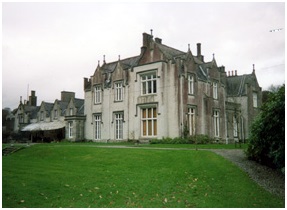
Colonel Lorenzo Moore, late of his Majesty’s Battle Axe Guards in Ireland, purchased the lease of the Manor & Lordship of Kilbride from Lady Ponsonby in the year 1824, the Moore family retaining possession up until the 1950’s. Much evidence of their sojourn there remains with us today. They built, for instance, the Manor house itself with the Gatelodge, the old Schoolhouse and teacher’s residence at Knockatillane and St. John’s Church at Cloughlea. They owned Kippure Lodge, and, of course, the village of Kilbride itself. The original lease was made by the Allens of St Wolstan’s, Celbridge to a Mr Fitzpatrick in the year 1700 for a term of 299 years.
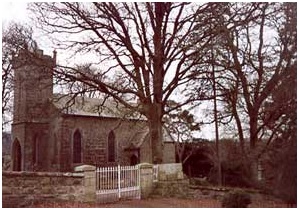
The church at Cloughlea was erected in the 1830’s. Tradition has it that the site was chosen because it was half way between Kilbride and another Moore possession, that of Kippure Lodge. I can’t help thinking the natural beauty and tranquillity of the spot was a major factor in making the decision. The waters of the close by river have delved deep down into the earth, exposing rocks-smoothing them over, and with overhanging vegetation create a timeless ancient feeling. The quaint bridge a little upstream adds to the picture. From a poetic point of view I think we must go to the great dreamer Yeats to do it justice. Recently I looked up Yeats’ poems on a website and picked out a few verses that I thought might be appropriate to catch its atmosphere. I quote from “The Stolen Child” in which the author imagines the fairies are taking away a child at night to save it from the sorrows of this world.
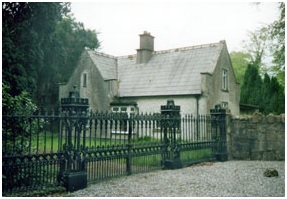
‘Where the wandering water gushes
From the hills above Glencar
In pools among the rushes
That scarce could bathe a star
We seek for slumbering trout
And whispering in their ears
Give them unquiet dreams:
Leaning softly out
From ferns that drop their tears
Over the young streams.
Come away o human child
To the waters and the wild
With a fairy hand in hand,
For the world’s more full of weeping
Than you can understand’.
It is one more corner of the beautiful county of Wicklow.
Many of the Moore family repose here within hearing distance of the Shankill river as it trundles on its way to the slower moving Liffey.
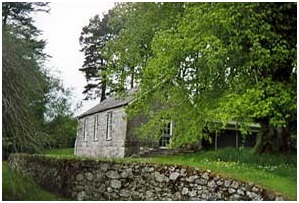
Local memory suggests there was a “Hedge School” at the top of “The Banks” in Kilbride in penal times. In the year 1831 the Government introduced National School Education for all of its children. In keeping with this new policy a school was set up in the village where the Craul family now live. All references to Irish culture, language, or history were, sadly, taken out of the school books. Even Moore’s Melodies were thought to be too sensitive for inclusion. Other than that there was a wide curriculum taught. Children brought a sod of turf each day during the Winter months. Improving landlords began to see education as a desirable method of uplifting the moral and intellectual fibre of the children of the tenantry and so Scott Moore built a new school at Knockatillane, which opened on the first of September in the year 1862 at which Catholic and Protestant children attended. It remained in use until in June 1968 another new school, St. Brigid’s, was opened in the village.
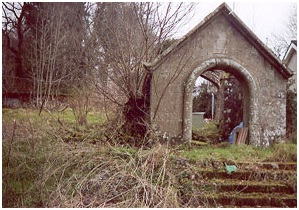
Recently I paid a history related visit to Glen Heste, formerly a Moore residence, now owned by the Rice family, and was shown around by Christopher. The entrance, of a later time, is still standing, and is of dressed granite. The house had obviously been of great stature. Beyond the ruins are the pleasure gardens which still retain some specimen trees. On further yet is the Pratt tomb with a high obelisk of polished granite. Captain Maurice Pratt, late 67th Regiment was buried here in 1884. Later on the house was converted to a hotel.
Kippure Lodge and lands were leased to a Mr Armstrong in the 1840’s. This man was instrumental in having Ballysmuttan Bridge built in the year 1848. You can still see the date etched on one of its stones. In her diary Mrs. Smith describes the laying of the first stone and the jollifications afterwards : 29th September 1848 :
To-morrow Mr. Armstrong gives a dejeuner at Kippure after a grand ceremony- the laying of the first stone of a bridge over the Liffey, near a dangerous ford where many have been drowned……………..Well! we really had a day of it, forty people besides Mob assembled at the ford. Lady Downshire laid the stone, presented with a silver trowel on a silk cushion by Mr. Armstrong; hurrahs quite deafening, then four horns played “God Save the Queen”…….Then all the carriages drove to Kippure……then the banquet, very well got up indeed, hot and cold, stout and sweet, fruit, flowers, champaign. We had a good song, retired to the drawing room, several good songs, coffee, tea, and then adjourned to the Barn, where all, high and low mixed in the Social dance…….(note: all this at the height of the famine when people were dying of hunger!)
When Ogle William Moore, rector of Blessington and Kilbride, was selling his interest in the Manor and Lordship of Kilbride it consisted of 4,441 acres (or thereabout) Irish Plantation measure, over 6,000 statute acres, to include the Townlands of Kilbride, Butter Mountain, Knockatillane, the Lesseens, Ballyfolane, Ballyfoyle, Adown, Scurlock’s Leap, Cloghoge and Glanbride. Kippure Lodge and lands may not have been included in this list. All tenements and structures on these lands were owned by the landlord. In order to ascertain title, that is, whether Mr Moore owned the estate outright, or held a long lease on it, and to find out if there were encumbrances on it their Solicitors drew up an Abstract of Title and carried out a Negative Search. In order to do this they went back to the year 1700 and trawled through the Registry of Deeds to search for any leases that had been drawn up over the years, had any Marriage settlements been made which gave money every year (an annuity) to a son or daughter: often an annuity or legacy was willed to a close friend or relative: worse still loans were often taken out to pay debts incurred by his Lordship in gambling and general debauchery, or a lavish lifestyle encouraged by her Ladyship. The inheritor seldom if ever came into possession of an estate that was not pretty well steeped in debt. We should remember too that payment of debts was strictly enforced in those days, even at the expense of selling part or all of an estate. A debtors’ prison, or Marshalsea, awaited the hopeless cases.
This scenario is, in fact, what faced the Rev. Ogle Moore in the early 1850’s. Rector Moore had lived way beyond his means. His wife was, unfortunately, of little help in that regard and had become accustomed to a certain style of living. She liked the gay social life of the city and kept up expected appearances.
Apart from his income from rents Ogle had a considerable tithe income. During the mid 19th century there was much discontent because of these charges. In fact in many places there were riots, especially in Co. Kilkenny, demonstrating at their inequity. Take the year 1833, for example! The Composition for all Tithes for that year for the Parish of Kilbride was £122-18-3, of which he received a portion. (He would also have an income as rector of Blessington). This amount was based on the average price of oats for seven years up until 1830. Everyone had to pay, and naturally the Catholic tenants felt particularly aggrieved. A further aggravation was that the tithe was only payable in regard tillage, so many ranchers like the Finnemores of Ballyward paid relatively little. We have details of the lives led by Ogle Moore and his family from the diaries of Mrs Smith of Baltyboys and of the doings of the Encumbered Estates Commission from documents in my possession. This article greatly relies on these two sources plus some references from Burke’s Peerage.
Another document of interest is the registration of trees planted by John Finnemore of Ballyward in the year 1849. They were planted in the townland of Ballyfoyle which was at that time leased from Ogle Moore. Improving landlords engaged in forestry cultivation for divers reasons. One, timber was an investment for the future. Also there was an R.D.S. grant available. Sometimes it was for the general improvement of their estates. It was a matter of pride for others and we are all aware of the specimen trees still growing on old estates, the seeds of which were sometimes brought from foreign parts when members of the gentry went on their grand tours. I don’t know which landlord was credited with the project, but the employment given was of great benefit at the height of the awful Irish famine when the poorer tenants lived in cabins in abject poverty and degradation. The trees and their number were as follows:
5,500 Scotch fir
5,250 larch
1,250 birch
1,000 oak
1,000 beech.
An affidavit to this effect was lodged at the Quarter Sessions in Baltinglass in the above year, and copied by Sam Fenton, deputy clerk of the peace.
Mrs Smith was a firm friend of the Moore family. She often went to the services in St. Mary’s Church conducted by Ogle: she visited the Manor House at Kilbride and she was in turn visited by Mr Moore at Baltyboys; she was involved with him in providing a library service and in doing charitable work. Later in life she persuaded him to pursue a literary career which he did, and with a measure of success. It did not, however prevent her from castigating his improvidence and high living. She took many a swipe at the lack of sense shown by his wife and the wife’s sister. They might well have kept him on the straight and narrow if they had tried. Some of the quotes from the Diaries are as follows: 14th Nov. 1847:
“Wednesday last the 10th we went early according to promise to the auction at Kilbride Manor of household furniture, all the farm stock had been sold before and ‘twas for the benefit of Ogle as his mother had given up to him everything except her bare jointure ( a yearly income from the estate )……We had a nice luncheon at the Lodge which is stuffed full of the bits of furniture from the manor which they did not like to let out of the family. A valuable library for one thing which arranged in handsome cases makes a pretty room a parlour”. Nov. 1849:
“The Moores have £240 for their income, all else being swallowed up by the interest on his personal debts….with this they are keeping 7 women servants and 4 outside men, and permit themselves every luxury and indulge in lives of utter indolence, neglect every duty, and say in tears “What can we do?” Mrs Moore knows of every debt except the one to the Doctor. Yet she makes no exertions…..They have many pressing tradesmen’s bills both in Dublin and Blessington………
The Moores agree to come and live in Blessington ( the present Ulster Bank ) provided Lord Downshire will repair it. They will let their own pretty cottage with or without more ground and make about £100 a year while they will save another £100 by buying vegetables etc. instead of cultivating about 40 acres at an outlay of 2 horses and 4 men. He will give up the Kilbride parish to a curate and sell his property the moment land rises. Will be better off living among us all instead of only with his bees and roses.”
Finally debts had to be paid and matters were taken in hand by the Encumbered Estates Commission. This body was set up to settle the affairs of those many Landlords who could no longer meet their commitments, exacerbated by falling rental income during and after the famine. So, in the year 1853 the estate, minus the Manor House and the home farm of 283 acres, was finally sold to a Mr Brown of Charlton upon Medlock in England. It realised the sum of £35,888 . Even after deducting £10,153-17-0 for the discharge of the Lease and settling debts, it left Ogle Moore well off financially and in a position to look after his 11 children, many of whom emigrated to Australia. Whether they moved to the Hotel in Blessington or remained on in the Manor House is not clear, but the Moore connection with Manor Kilbride very much continued on for in the year 1857 the Manor was bought back by Scott Moore. (In fact Scott Moore was married to Brown’s daughter.)
The Rev Moore took Mrs Smith’s advice about writing and was quite successful in that respect. In later years we hear of him travelling to England on a commission that was looking into Education.
The present owner of the Manor House has some acres around it. The rest of the Manor farm is in the possession of a local family. The outlying areas have long since been bought out by the former tenants. The house is in good hands and its future looks bright. The walled garden is still there and much cultivation takes place within it. The cabins of the former tenants are no more. In their stead are grand houses, and every bit of land is worth a small fortune. Those families who have stuck it out have prospered.

Any comments or questions would be welcome: To contact Jim Corley please click here


Leave a Reply